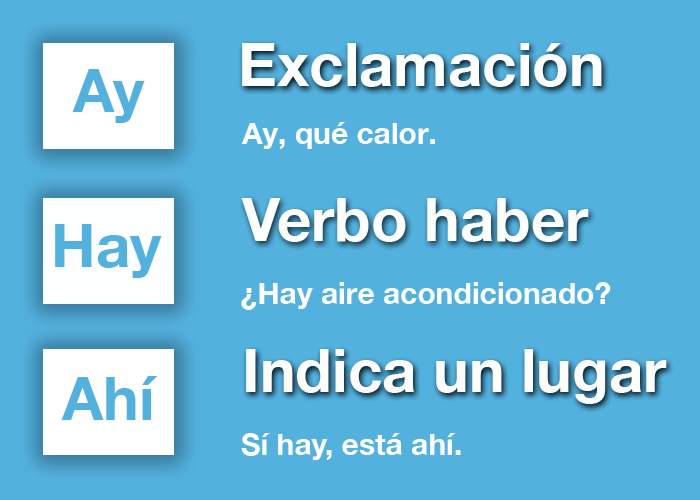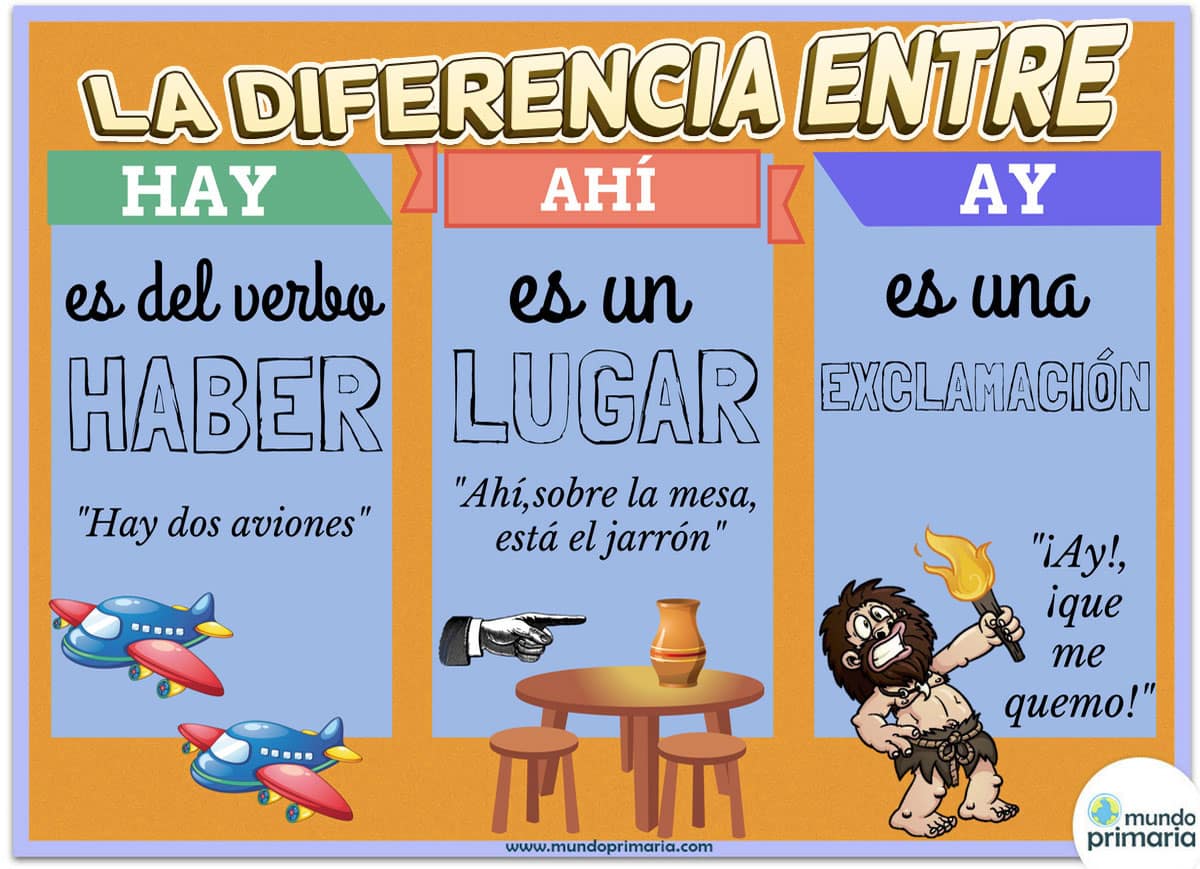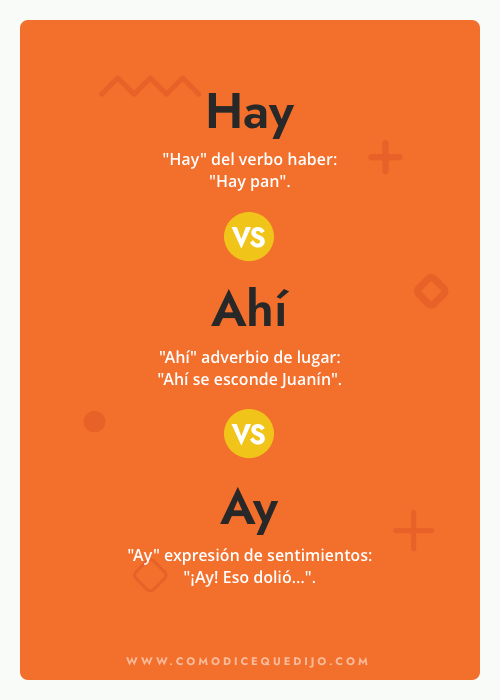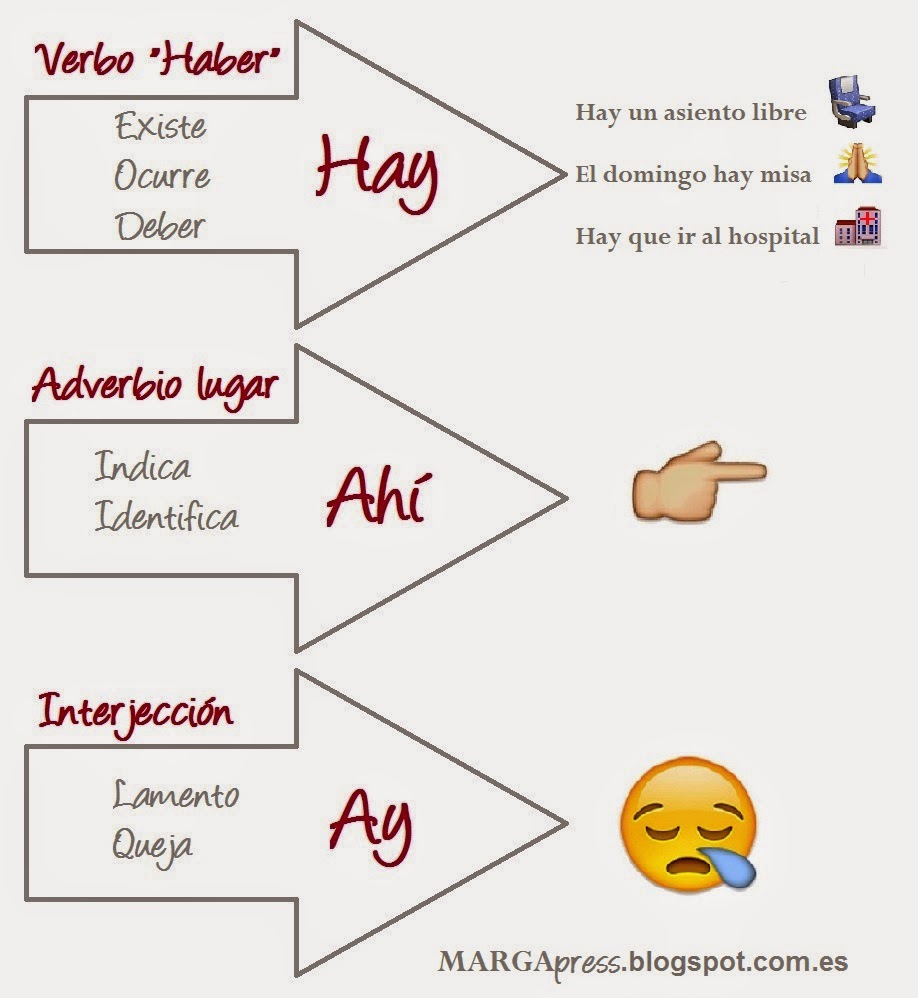
diferenciaentreayhayyahiparaestudiantesdeespanol
Hay, Ay o Ahí. Hay es el verbo haber conjugado en su forma impersonal; ay es una interjección que puede expresar pena o temor, mientras que ahí es un adverbio de lugar, equivalente a 'en ese lugar'. Tanto hay como ay son palabras homófonas, que suenan igual, mientras que ahí es una palabra aguda, y, en este sentido, se diferencia de.

¿Hay, ahí o ay? Las reglas de ortografía. Vídeos educativos para niños
hay. Hay is the impersonal form of the verb haber. It can be translated as there is or there are. Example: Ya hay flores en el jardín. Hay can be conjugated in all tenses in both the indicative and subjunctive moods. However, unlike English, hay is only ever conjugated in the third person singular, even when it refers to a plural object. Example:

Diferencias entre Ay, Hay y Ahí (Significado y comparación) Cuadro
Their meaning is different, their spelling is different, and yet, they sound the same. What are they? The Spanish words ¡ay!, hay, and ahí. ¡Ay! and ¡ahí! ca.

TOMi.digital Uso del hay, ahí , ¡ay! Reglas ortográficas!
'Hay' is the impersonal form of the verb haber, therefore, it has many uses.However, one of the most common ones is to express existence. In this context, 'hay' is the direct translation of the English expression 'there is' or 'there are'.. Hay muchos gatos en la calle There are many cats on the street. Finally, 'ahí' and 'allí' are adverbs of spatial position or.

Ay Hay Ahí Ortografía, Reglas ortograficas, Centros de aprendizaje
Ay.Se trata de una interjección que expresa diferentes estados de ánimo, por lo general dolor, queja o aflicción. Por ejemplo: ¡Ay, jamás pensé que esto terminaría así! Ahí.Es un adverbio de lugar que indica "en ese sitio". Por ejemplo: Dejé las cosas ahí, pero ya no están. Hay.Es el verbo "haber" conjugado en presente del modo indicativo, y se trata de una forma impersonal.

Ahí, ay, hay Tecnicas de aprendizaje, Material escolar en ingles
La palabra ahí, escrita así con h intercalada y con tilde en la i, es un adverbio de lugar y como su nombre indica señala una posición o un lugar. Ahí está María con su bicicleta. Mira el delfín ha saltado por ahí. Como podéis ver en estas dos frases la palabra ahí nos indica, nos señala, un lugar. Donde están María y el delfín.

Que Diferencia Hay Entre Hay Ay Y Ahi Esta Diferencia
¿Qué significan y en qué casos se utilizan las palabras: "ay", "hay" y "ahí"? "Ay" y "hay" son palabras homófonas (aquellas que se pronuncian igual, pero, se escriben y significan distinto y "ahí" es una palabra parónima (aquellas que tienen cierta similitud con otras) con respecto a las dos primeras.Ahora miremos qué significan y cómo se utilizan:

Infografía educativa sobre las diferencias entre Hay, ahí y ¡ay
Qué: Cómo utilizar y escribir correctamente 'hay', 'ahí' y 'ay'. ¿Es 'hay', 'ahí' o 'ay' la expresión correcta? ' Hay ', ' ahí ' y ' ay ' representan uno de los más populares quebraderos de cabeza que los hispanohablantes enfrentamos a menudo. Especialmente en las escuelas. Por eso, desde Estandarte.com damos una breve explicación y.

hay,ahí,ay Tenspanish
Introducción. Las palabras hay, ay y ahí se escriben y se pronuncian de manera muy parecida pero tienen significados totalmente distintos. Esta explicación comparada te ayudará a comprender la diferencia que existe entre ellas de manera definitiva. En la sección de ejercicios puedes poner a prueba tus habilidades gramaticales y afianzar así tus conocimientos.

Que Diferencia Hay Entre Hay Ay Y Ahi Esta Diferencia
Ahí is an adverb of place, like allí and aquí. Ay is an interjection used generally as an exclamation (with corresponding exclamation marks [ ¡ !]), indicating surprise or pain. Hay and ay are pronounced the same but there is more emphasis on ay because of the exclamation: ¡ay! Ahí is not pronounced the same as hay and ay.

Hay, Ahí o Ay Cómo se escribe y diferencias ¿Cómo dice que dijo?
3. It's worth noting that many people (at least in Mexico) write 'hay' when they mean 'ay'. It confused me for a while. - Flimzy. Nov 16, 2011 at 17:24. yeah, is misleading sometimes I even get confused to,I wonder why most of the people (at least in Mexico) can't get it right. - isJustMe. Nov 16, 2011 at 17:30. 6.

Diferencia entre Hay, Ahí y Ay? En la siguiente imagen te lo aclaramos
¡Ay!, hay, ahí. Are you having trouble to learn them?Learn Spanish expressions in 60 seconds!! 🔥 Join our 5 Day Spanish Masterclass here: https://www.lingom.

Diferencia entre Hay Ahí ¡Ay! Educacion integral, Ortografia
HAY, AHÍ and AY are three Spanish words that sound exactly the same, but they are very different from each other, even belong to different grammatical categories. HAY, AHÍ vs ¡AY! examples. 1. HAY (there is, there are) is an impersonal form of the verb haber, used to indicate the existence of something. ¿No hay nadie en aquí? (There's no.

Las diferencias entre hay, ay y ahí La página del español
Hay is a verb that expresses existence, similar to the English phrase "there is/are.". On the other hand, ahí is an adverb that refers to a place far away from the speaker, similar to the English word "there.". Meanwhile, ay is an interjection that can express a wide range of emotions, such as surprise, pain, or annoyance.

Ortografía La diferencia entre hay, ahí y ay. bilingualeducation
The Meaning of Hay. The word hay, an impersonal form of the Spanish verb haber , is used to express existence. In other words, hay is the Spanish equivalent of "there is" and "there are." Let's see a couple of clips that include it: Encima de ella, hay una lámpara negra. Above her, there's a black lamp.

MARGA PRESS Hay, ahí, ay
Nov 11, 2022. LITTLE VALLEY — A Cattaraugus County grand jury has handed up a 10-count indictment against a Little Genesee man in the Sept. 3 death of an Olean teen in Portville. Skyler Hess, 20.